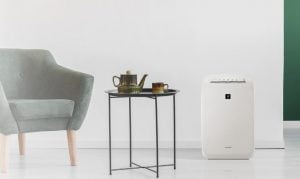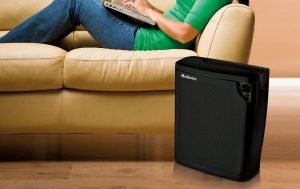Ionic Air Purifier 101
An ionic air purifier is a type of air purifier that works by ionizing air particles, hence the name ionic. Ionizing air purifiers charge air particles with either positive or negative charges, with negative charges being more common. Those negative charges are even used to be thought to have positive effects on health.
Types of Ionic Air Purifiers and How They Work.
Some ionic air purifiers send charged ions out of the machine, so they can attach themselves to air particles while others draw the air particles in and subsequently charge them. Either way, the results are the same. Air particles are charged or ionized.
Hence, we actually have two types of ionic air purifiers: a simple ionizer air purifier, and electrostatic precipitator air purifier.
A simple ionizer air purifier sends charged ions out of the machine and then lets the charged particles to settle to a surface, ready to be wiped out by the home owner.
In contrast, an electrostatic precipitator air purifier collects the charged particles in a series of metal plate collectors inside the machine. Hence, while a simple ionizer simply makes the airborne particles to settle because of the charges and does not do anything to actually remove the particles, an electrostatic precipitator draws the charged particles into the machine.
Since a simple ionizer air purifier just moves the airborne air particulates to various surfaces, it is not effective enough to clean up air when used on its own. Therefore, most air purifiers have ionizers only as an add-on or optional filtration technology to a HEPA air purifier.
if you are looking for an ionic air purifier with no HEPA filter, a more appropriate approach is by purchasing the ones which draw the charged particles in and collect them in a series of plate collectors, which are also known as electrostatic air purifiers. That way, the dust is removed from the room quickly and efficiently.
NOTE: for more discussion on whether ionic air purifiers work and which ones work, click here. Yet, another way to do it, is by using another kind of ionization which indirectly produce hydroxyl radicals, known as plasma technology.
In this scenario, the ionizer releases partially charged particles which, in the presence of water vapor from the air, can turn into hydroxyl radicals. Hydroxyl radicals, like ozone, are unstable and highly reactive. They readily attack volatile organic gases, viruses, bacteria and other gases; either killing them or changing the chemicals into harmless air molecules. After the reaction takes place, the hydroxyl itself changes into water molecules. Therefore, unlike conventional ionizer air purifier which merely turn the suspended air particles into settled air particles, plasma technology really removes the air pollutant from the room by converting them into harmless chemicals.
The hydroxyl radical production technology or plasma technology is wonderful when used concomitantly with other filtration technologies, such as HEPA filtration since they complement each other well; HEPA being a superb filter for particles bigger than 0.3 micron, and plasma technology being an excellent fine-particle remover. In addition, as an oxidizer, they are very short-lived and unlike ozone, they won’t hang out in your house for days. Therefore they are safe to use. By the way, this technology has been used in conjuction with other air filtration technology with good results by Plasmacluster air purifier by Sharp and Winix Plasmawave Air Cleaner.
Ionic Air Purifier – Is It Safe ?
Due to the high voltage required to produce electric field in electrostatic air cleaners, ionizing air purifiers produce some amount of ozone. EPA gives a limit of 50 ppb ozone to any electronic device to ensure safety, but it is important to understand that 50 ppb of ozone is not background ozone and is not negligible. This means, that you will be able to smell the ozone and sensitive people may not be able to stand it. Ozone is a powerful oxidant and can irritate soft tissues such as our eyes as well as respiratory pathways. Lung sufferers, in particular, are better off not to go near to any of ozone-producing ionic air purifiers because of high possibility of respiratory pathway irritation.
Potential buyers need also to know that although EPA has set up a limit of ozone production, a small number of air purifiers do not follow this guidelines and yet, they still manage to find their ways to the residential air purifier market.
With all this information, does it mean you have to avoid ionic air purifiers altogether ?
We think that you should avoid ozone-producing ionizing air purifiers. Fortunately, there are a small number of ionizer which do not emit ozone or only emit a background/negligible amount of ozone. Online vendors or the manual can give you information whether a particular product is ozone-free.
Positive Aspect of Ionizer Air Purifiers
- No filter replacement required.
- Quieter than HEPA air purifier. This is because the unit breathes better, as opposed to a HEPA air purifier unit which has a filter barrier. Therefore, the fans of an ionizing air purifier does not have to work hard to push the air through the air purifier.
Negative Aspects of Ionic Air Purifiers
- Many ionizers are ozone producing and therefore are not safe.
- Owners of electrostatic precipitator has to wash the metal collection plate often to ensure the continued effectiveness of the unit.
- Owners of simple ionizers which does not collect air particles, may not find the unit to be effective at all since ionizers just move the dust from the air to a surface and do not actually remove the dust from the room.
- In general, ionic air purifiers are less effective than HEPA air purifiers, unless the ionic air filtration technology is combined with the HEPA air filtration system. Otherwise, a pure ionic air purifier can only, at maximum, provide all around cleaning and is very unsuitable to address people with problem, such as allergy, asthma, smoke, and so forth.




